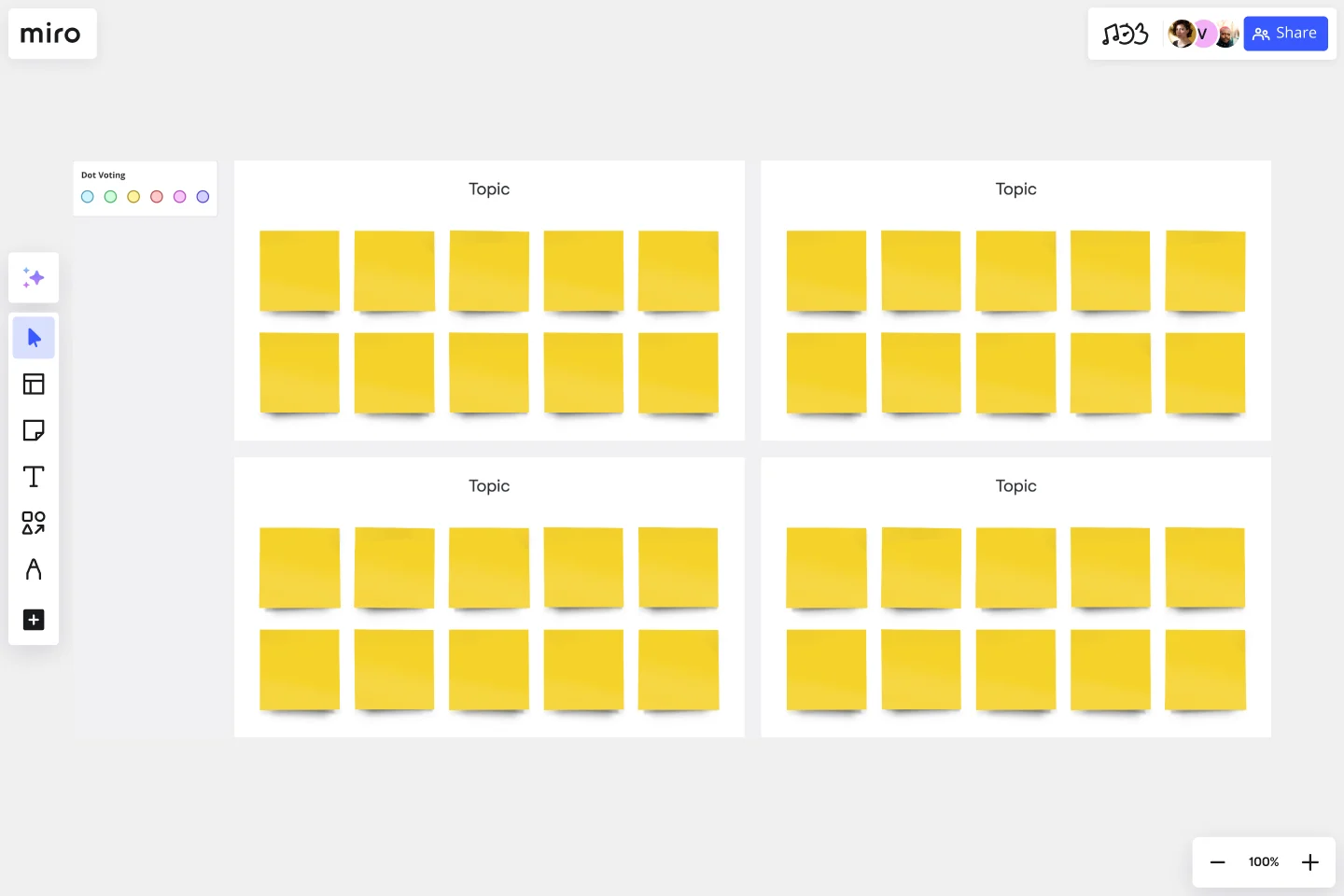Research Topic Brainstorm Template
Align research goals, cluster ideas, and debrief with stakeholders.
About the Research Topic Brainstorm Template
Before you can sign off on your UX research plan, you need to know you’re asking the right research questions. A research topic brainstorm with your team can ease navigating the different stages of the design process, from discovery to testing.
Whether you’re doing stakeholder interviews or user group outreach, you should focus on the right topics and ask questions that generate useful insights. To ensure that you understand your customers and translate that knowledge into intelligent and inspiring design solutions, first brainstorm with your team what (or who) is worth researching.
What is a Research Topic Brainstorm
Research topic brainstorming helps you generate questions for stakeholder or user interviews based on topics like partnership opportunities or first-time experience.
Ideally, brainstorming questions worth asking during user research activities can help you clarify:
Your user research objectives: What questions are you trying to answer? What do you need to know at this point in the design process?
Your user research hypotheses: What do you already know? What are your assumptions? What do you think you understand about your user’s behavior, and potential solutions you can fulfill based on unmet needs?
Your user research methods of choice: How will you fill in your knowledge gaps? Based on the resources available, what methods will you choose?
Use these three steps to turn your brainstorming session into a repository of questions. Aim for 3-5 prioritized research questions in your UX research plan document.
When to use Research Topic Brainstorms
Research topic brainstorming happens in the early stages of user research and enables you to build a foundation, generate inspiration and ideas, and evaluate design choices to better serve user needs.
A research topic brainstorm can help UX researchers:
Frame questions in the “5 Ws and H” structure (who, what, when, where, why, how), so your team can generate a variety of insightful questions (but remember to keep your research objective specific!).
Prioritize questions needing to be answered right away and those that can be more valuable later on.
Externalize hypotheses to minimize external bias (such as client or team influence).
Choose the right research methods to fulfill your objectives.
Use your early hypothesis to demonstrate and compare what you actually discovered during research.
Create your own Research Topic Brainstorm
Making your own research topic brainstorms is easy. Miro is the perfect tool to create and share them. Get started by selecting the Research Topic Brainstorm Template, then take the following steps to make one of your own.
Define key research areas. Do you want to look at new opportunities for partnering with other business areas? Improve your app’s onboarding flow for new users? Pick 1-4 key topics your team thinks are worth exploring.
Brainstorm questions relevant to each research topic. Aim for quantity first, then prioritize for quality and impact. Keep criticism aside. Also, this part of your research brainstorming should be timebound (try the Countdown Timer) and tied back to your business goals and user needs.
Identify research or knowledge gaps. Based on what you’ve just brainstormed, what’s missing? What don’t you already know? Record these missing elements on sticky notes as well.
Ask relevant stakeholders or team members for feedback. Invite collaborators onto your Miro Board using a preferred method (like sharing public links to invitations to edit via Slack or email).
Add your preferred research questions to your UX research plan. Your prioritized research questions form an important segment on your UX research plan – copy over the sticky notes and update your research plan accordingly.
Get started with this template right now.
User Story Map Template
Works best for:
Marketing, Desk Research, Mapping
Popularized by Jeff Patton in 2005, the user story mapping technique is an agile way to manage product backlogs. Whether you’re working alone or with a product team, you can leverage user story mapping to plan product releases. User story maps help teams stay focused on the business value and release features that customers care about. The framework helps to get a shared understanding for the cross-functional team of what needs to be done to satisfy customers' needs.
Niching Down: Online Course Persona Empathy Map
Works best for:
Market Research, Research & Design
Niching Down Online Course Persona Empathy Map helps you tailor online courses to specific personas. By understanding their needs and motivations, you can design more effective and engaging course content. Perfect for course developers and educators.
Empathy Map Trevotech
Works best for:
Market Research, Research & Design
Empathy Map Trevotech is a powerful tool for gaining insights into user experiences. It helps you capture and analyze user emotions, thoughts, and behaviors, ensuring your product designs meet user needs effectively.
Service Blueprinting Workshop
Works best for:
Agile
The Service Blueprinting Workshop template helps teams visualize and improve service processes. It includes ice breakers, context canvas, empathy maps, and action plans for service transitions. Use it to align teams, identify opportunities, and prototype service delivery from a macro to microscopic level, ensuring a comprehensive understanding of service orchestration and seamless collaboration. Ideal for remote and dispersed teams.
Empathy Map Template by Jeshua MacDonald
Works best for:
Market Research, Research & Design
The Empathy Map template is essential for anyone looking to understand their audience better. It helps you gather insights into user thoughts and behaviors, allowing you to design more user-centered products and services. Perfect for UX designers and marketers.
Year Timeline Template
Works best for:
Timeline, Planning
The Year Timeline template provides a comprehensive view of annual events and milestones. Perfect for planning yearly goals, tracking progress, and scheduling important dates, this template helps you stay organized and focused throughout the year.
